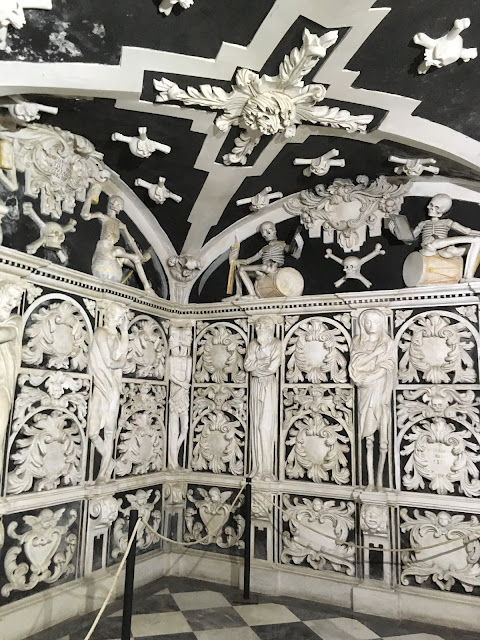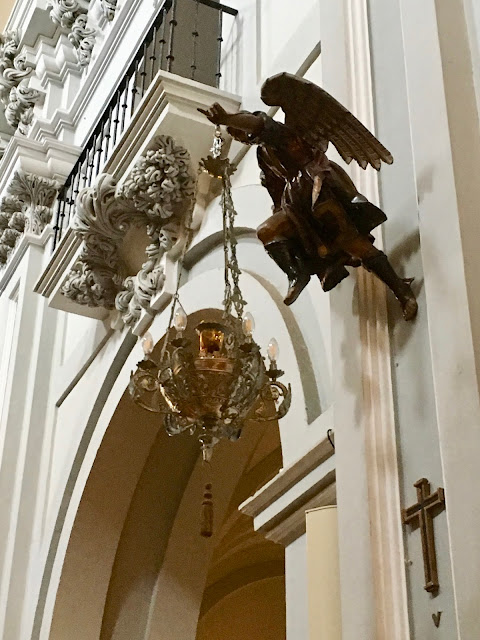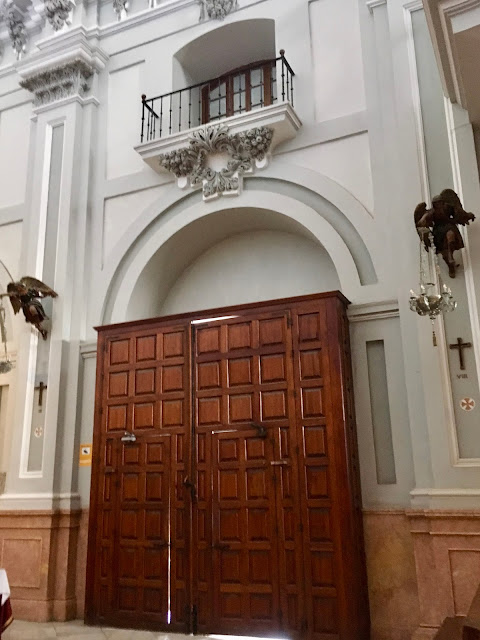Sometimes one discovers a gem quite by accident and such is the case of the rather drab exterior of the Santa Maria de la Victoria Basilica.
Visitors enter the building by way of a side entrance next to a children's playground.
There is little signage and if not for glowing reviews and detailed instructions on TripAdvisor I'm unsure we would have found our way. The entrance is below, bottom right.
Entry into the crypt and tower is free, but one is required to take a guided tour and afterwards a donation of €2/person is readily accepted. (It's worth every penny!)
Our guide, with beard and brown sweater (above), was enthusiastic, devout and proud to show us around the basilica where his parents were married and he is now an elder. We entered via a small reception room (visible through the double doors behind him) into the crypt and for maximum affect he turned the lights on only after we'd all assembled inside. The black and white splendour literally took our breathes away and we were all speechless.
In the 1700s the original basilica fell into disrepair and was torn down. When the Counts of Buenavista approached the monks and offered to finance the rebuild if they were granted a family burial crypt, the monks accepted, but on the sole condition they would have total control of the basilica's design. The Buenavistas agreed.
The exterior of the basilica is surprisingly plain considering the elaborate baroque style that was in fashion at the time, but our guide explained this is due to the monks belief that what is on the outside is unimportant. It's what is on the inside that counts, and they wanted to visually convey this to their parishioners.
Every detail of the crypt deals with the living in all of its complexities and stages.
To remind us of the choice to be either good or bad - and thus determine where we might spend eternity - there are seven devils lurking inside the crypt. One is between the two men below.
An interesting twist to this story is the bodies of the Counts of Buenovista were never laid to rest inside the crypt.
Before it was completed they moved to Madrid where they died and their remains were interred there. However, they do have a special place set aside for them in the Malaga crypt - just in case!
Next, we climbed a series of stairs leading to the Heavenly Tower. The decorative details on the walls and ceiling give some indication of the splendour to come - but only a hint!
Then, we stepped into the tower through the door on the right (below)...
...and our eyes are immediately drawn skyward past the mind boggling, intricate baroque sculptures and carvings to the blue dome high above our heads.
The detailing is literally more than the brain can compute.
At the base of the tower are painted tiles that act as a connection between the Heavenly tower and the floor.
What was missing in the Heavenly Tower was the statue of the Santa Maria de la Victoria. She normally rests atop a huge stand in the middle of the room.
John and I tried to imagine how the tower would look if she'd been present, but failed miserably! The reason she's been moved into the basilica is repairs to the tower will start soon and tours will resume in 18-20 months. But more about Santa Maria later as the next stop is a small museum right next door that features many of the different capes that once adorned her statue.

The green cape shown above and below is noteworthy not only because it took 20 seamstresses two and a half years to embroider with gold and silver threads, but because it was commissioned by Malaga born Anita Delgado who became the Princess of Kapurthala. (Click the link to read more about her.)
After she married an Indian maharajah and her first son was born, both the child and princess barely survived. Anita prayed to Santa Maria, vowing to make the saint the finest cape in the entire world - as long as she and her son survived.

Both did and she commissioned the cape to be made. Sadly, it was never accepted by the city locals or church. Nor did it ever grace the statue that she attributed to saving her life. Because Delgado married outside of the Catholic faith she outraged the locals and was barred from returning to Malaga. (She mailed them the cape.) When it arrived the citizens wanted to toss it into the Mediterranean. The bishop, however, suggested they put it in storage inside the basilica and forget about it - which they did until it was recently added to this display.
 |
| Close-up |
The other capes for Santa Maria are equally impressive, not only for their gold and silver threads and intricate stitching, but also the addition of pearls and other precious gemstones.
Even Queen Isabella commissioned a cape to be made for Santa Maria, but in 1939 it was determined that wearing these heavy capes was actually destroying the neck and shoulders of the statue.
Since then, each September 8 when she is paraded through the streets of Malaga she does so without an accompanying cape.
The small museum also contained other religious artifacts, including at least three or four magnificent silver candelabras.
Both the crypt, Heavenly tower and basilica is open to the public for only a few hours per day. All close at 1:00 PM and so we returned a second day to see the interior of the basilica. It was well worth the effort.
If you look carefully at the photo above you may notice a head peeking around the right side of the red curtain beside Santa Maria. It's our tour guide who is in the Heavenly tower and no doubt leading another group of tourists.
We were fortunate to visit the basilica at the same time volunteers were working on one of the floats that is carried through Malaga on the September 8th annual progression.
On either side of the basilica were a number of alters - each as exquisite and detailed as the next.
Finally, we stepped outside the basilica and entered a courtyard next door. Talk about a serene resting place in the middle of the city.
* * *





















































